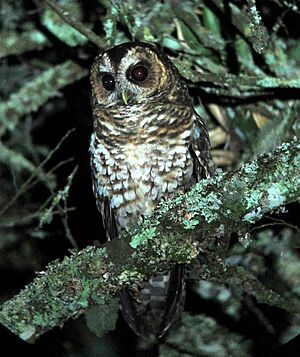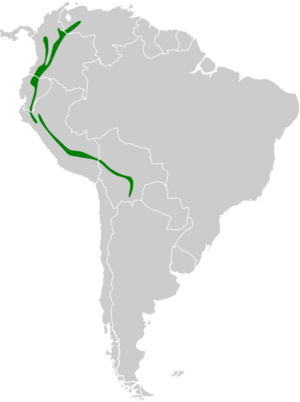Rufous-banded owl facts for kids
Quick facts for kids Rufous-banded owl |
|
|---|---|
 |
|
| Conservation status | |
| Scientific classification | |
| Genus: |
Strix
|
| Species: |
albitarsis
|
 |
|
| Synonyms | |
|
Ciccaba albitarsis |
|
The rufous-banded owl (Strix albitarsis) is a type of owl that belongs to the owl family, Strigidae. You can find this owl in several South American countries. These include Bolivia, Colombia, Ecuador, Peru, and Venezuela.
Contents
About the Rufous-Banded Owl
The rufous-banded owl is a medium-sized bird. It measures about 30 to 35 centimeters (12 to 14 inches) long. Some owls of this species have weighed between 265 and 350 grams (9.3 to 12.3 ounces). This owl has a round head and does not have ear tufts, which some other owls have.
Its face is a reddish-brown color, and it has bright orange eyes. Around its eyes, the feathers are darker, almost black. It also has white "eyebrows" and white feathers near its beak. The top of its head and its back are dark brownish-black. These parts have reddish-brown bars and spots. Its tail is also dark brownish-black with lighter bars.
The owl's chest is dark brown with white and yellowish-brown bars and spots. The rest of its belly is silvery white and reddish-brown. This pattern looks like small eyes, which is called "ocellated." Young rufous-banded owls are yellowish-brown with a dark mask on their face.
Where Rufous-Banded Owls Live
You can find the rufous-banded owl in the Andes Mountains. This mountain range stretches from northern Venezuela all the way south to western and southern Bolivia.
These owls prefer to live in wet, evergreen montane forests. They also live in cloudforests. These forests usually have lots of dense plants growing close to the ground. They also have many epiphytes (plants that grow on other plants) and mosses. In Venezuela, these owls have also been seen in more open areas next to thick forests. They typically live at high elevations, from about 1,700 to 3,700 meters (5,600 to 12,100 feet) above sea level.
Owl Behavior and Habits
What Rufous-Banded Owls Eat
The rufous-banded owl is a nocturnal animal. This means it is active and hunts at night. It usually starts looking for food soon after the sun goes down. These owls hunt for food in the tops of the forest trees. They have also been seen hunting from branches at the edge of the forest. Scientists believe they mostly eat insects and small mammals.
Owl Reproduction and Young
Not much is known about how rufous-banded owls raise their young. However, a young owl that had just learned to fly was seen in Colombia in late June. Another young owl was spotted in Venezuela in August.
Owl Sounds and Calls
The main sound the rufous-banded owl makes is a quick series of 5 to 10 short, deep, gurgling notes. After a short pause, it makes a loud, higher-pitched note. It sounds like "hu hu hu hu hu, HOOa." It also makes a series of rough, single hoots, like "rrroo rrroo rrroo rrroo..."
Conservation Status
The IUCN (International Union for Conservation of Nature) has listed the rufous-banded owl as a species of "Least Concern." This means that it is not currently in danger of disappearing. However, cutting down its forest home could harm this owl.


